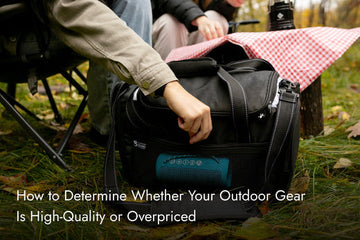Is Your Outdoor Gear Worth It? | Geckobrands

Whether you're an avid hiker, camper, or weekend adventurer, choosing the right outdoor gear is crucial. But with so many brands and options, it’s easy to wonder: Is this gear worth the price, or am I paying a premium for a flashy logo? Understanding the difference between high-quality outdoor gear and overpriced products can save you money and enhance your outdoor experiences.
In this blog, we’ll explore key features to look for when buying outdoor gear and how to make informed decisions.
What Makes Outdoor Gear High-Quality?
High-quality outdoor gear is designed to withstand the demands of nature. It combines durability, functionality, and comfort to ensure you stay safe and dry during your adventures. Here are the hallmarks of premium outdoor equipment:
1. Durability
Quality outdoor gear should stand up to harsh conditions like rain, wind, and rugged terrain. Look for products made with materials known for their durability:
-
Ripstop Nylon or Polyester: Ideal for backpacks and tents.
-
GORE-TEX or eVent: Popular in waterproof jackets and boots.
-
Stainless Steel or Titanium: Common in cookware and tools.
Durable gear not only lasts longer but also performs consistently over time, making it a worthwhile investment. It’s best to invest in durable materials upfront.
2. Functionality
Great outdoor gear serves its purpose effectively. For example:
-
Jackets should be lightweight, waterproof, and breathable.
-
Sleeping bags should provide adequate insulation for your intended environment.
-
Backpacks should offer ergonomic designs, adjustable straps, and ample storage.
Evaluate whether the product’s features align with your needs. A multifunctional tool that you’ll never use is just added weight to your pack.
3. Comfort
Comfort is non-negotiable, especially for long trips. High-quality gear prioritizes your well-being:
-
Well-padded boots prevent blisters and foot fatigue.
-
Adjustable backpacks distribute weight evenly.
-
Breathable clothing reduces overheating and sweat buildup.
4. Brand Reputation
While brand names don’t always guarantee quality, established brands often have a track record of producing reliable gear. Research customer reviews and outdoor enthusiast forums to see how a product performs in real-life scenarios.
Signs Your Gear Might Be Overpriced
Expensive doesn’t always mean better. Here are some red flags that a product might not deliver value for its cost:
1. Unnecessary Features
Some products are loaded with features you’ll never use, adding cost without practical benefits. For example:
-
Overly complex backpack designs with redundant compartments.
-
Gadgets with limited real-world application.
Focus on gear that’s functional rather than flashy.
2. Lack of Transparent Materials
High-quality brands proudly share what their gear is made of. If a product doesn’t specify materials or construction methods, it may not justify its price.
3. Brand Markup
Sometimes, you’re paying for the name rather than the product. Look for smaller, reputable brands that deliver comparable quality at a lower price. Don’t be swayed by marketing alone.
Key Tips for Choosing High-Quality Outdoor Gear
Shopping for outdoor gear doesn’t have to be overwhelming. Use these tips to make confident decisions:
1. Define Your Needs
The right gear depends on your activities:
-
Are you hiking, camping, or climbing?
-
Will you be in wet, cold, or hot conditions?
Knowing your specific requirements helps you avoid unnecessary features and focus on gear that suits your adventures. Prioritize lightweight backpacks for longer hikes.
2. Inspect Construction and Materials
Examine the product’s build:
-
Are the seams reinforced?
-
Is the stitching clean and even?
-
Do the zippers feel sturdy?
These details often indicate the overall quality of the item.
3. Test Fit and Comfort
Whenever possible, try the gear before buying:
-
Wear backpacks with a load to see how they feel.
-
Try on boots to ensure a proper fit.
-
Set up tents to test ease of assembly.
4. Consider Warranties and Customer Support
Reputable brands stand by their products with warranties and excellent customer service. This safety net can be invaluable if your gear fails unexpectedly.
5. Research and Reviews
Before purchasing, read customer reviews and product comparisons. Look for insights on:
-
Performance in various conditions.
-
Durability over time.
-
Comfort and ease of use.
Outdoor forums, YouTube reviews, and expert blogs are great resources! User reviews help to find hidden gems that aren’t heavily marketed.
Balancing Quality and Budget
High-quality gear doesn’t have to break the bank. Here’s how to balance quality with affordability:
1. Invest in Key Items
Spend more on essential gear like boots, jackets, and sleeping bags. These items have the biggest impact on your comfort and safety.
2. Shop Sales and Secondhand
Look for deals during off-season sales or check secondhand stores and online marketplaces. Often, lightly used gear is just as good as new.
3. Prioritize Versatility
Choose gear that works across multiple activities. For example, a good hiking jacket can double as a raincoat for casual wear.
FAQs About Outdoor Gear
How Do I Spot Cheap Gear?
Cheap gear often has uneven stitching, weak zippers, or generic materials. These items may work initially but won’t withstand frequent use.
Is Expensive Gear Always Worth It?
Not always. Focus on the product’s features, materials, and reviews rather than just the price tag.
How Often Should I Replace Outdoor Gear?
It depends on usage and maintenance. Regularly inspect your gear for signs of wear, like thinning fabric or frayed seams, and replace items when they compromise safety or performance.
Final thoughts
Choosing outdoor gear doesn’t have to be a gamble. By understanding what makes gear high-quality and recognizing overpriced items, you can make smarter purchases. Focus on durability, functionality, and comfort while considering your specific needs. With these tips and a little research, you’ll be ready to invest in gear that enhances every outdoor adventure.

